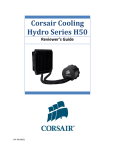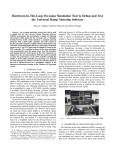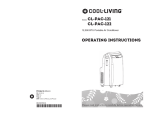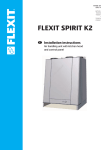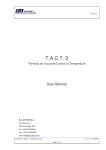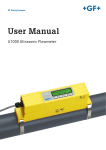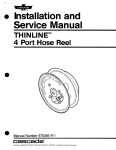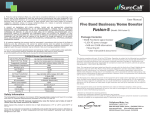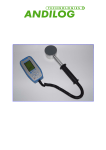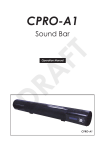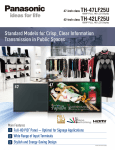Download Nanoxia CF No.1 UV
Transcript
Technical Information Antifreeze and Anticorrosion Concentrate for Heating and Cooling Circuits. Medium for Ground Source Heat Pump Systems CoolForce 1 posseses excellent stability at high temperatures and prevents the formation of harmful deposits on hot metal surfaces (at temperatures of up to 200 °C) at watt densities as high as about 40W/cm 2 . It thus helps to avoid overheating at heat-transfer surfaces and the formation of deposits in the circuit, and thus ensures consistently high thermal efficiency of the system. Characteristics of CoolForce 1 Concentrate Appearance lear, colourless liquid Boiling point > 165 °C ASTMD 1120 Pour point < -15 °C DIN ISO 3016 Density (20 °C) 1.120–1.125 g/cm DIN 51757 Viscosity (20 °C) 24–28 mm 2 /s DIN 51562 Refraction nD20 1.432–1.434 DIN 51423 pH value (20 °C) - concentrate 8.0–8.5 ASTMD 1287 - 33 vol. % 7.5–8.5 ASTM 1287 Water content max. 4 % DIN 51777 Flash poin > 100 ° DIN 51758 Reserve alkalinity > 10 ml 0.1 m HCl ASTMD 1121 Miscibility CoolForce 1 is miscible with all commercial antifreezes based on ethylene glycol. If mixing of CoolForce 1 with other products is intended, we recommend, however, to contact our department of application technique beforehand. Application The above data represent average values that were valid when this Technical Information Bulletin went into print. They do not have the status of a product specification. Specified values are the subject of a special leaflet. CoolForce 1 is added to water (potable water quality, with a maximum chloride content of 100 mg/kg, or demineralised water) in concentrations of at least 20 percent by volume. The protection against frost deteriorates if the content of CoolForce 1 exceeds 58 percent by volume. Properties CoolForce 1 is a clear, colourless, and virtually odourless liquid based on ethylene glycol. The product is used as antifreeze / corrosion protection fluid and heat-transfer medium for heating, air conditioning and cooling circuits, as well as brine for heat pump systems. Temperature stability Sustained temperatures higher than 140 °C cause premature ageing of the heat-transfer fluid, but brief exposure to temperatures higher than 140 up to 200 °C can be tolerated if the liquid is subsequently cooled. At temperatures above 200 °C, the heat-transfer fluid commences to undergo chemical change, with the result that the dependability of the installation may be endangered. A blanket of nitrogen is recommended to lengthen the life of the heat-transfer fluid if the sustained operating temperature is higher than 110 °C. CoolForce 1 is miscible with water in all proportions. CoolForce 1 / water mixtures protect against frost at temperatures down to -50 °C, depending on their concentration, and lengthen the life of the installations that they protect. Water hardness constituents do not affect the performance of the product, and do not lead to precipitations from the heat-transfer fluid. Mixtures of CoolForce 1 and water do not separate. The corrosion inhibitors of CoolForce 1 reliably protect the metals normally used in heating and cooling systems against corrosion, ageing and deposits over long periods even in mixed installations. CoolForce 1 neither contains borax nor nitrites, phosphates, nor amines. Anticorrosion Effect The following table demonstrates the anticorrosion effect of a 33 vol. % CoolForce 1 / water mixture after a 14 days test at 88 °C under permanent aeration. Corrosiontest accordingly ASTMD 1384 (American Society for Testing and Materials). PC-Cooling GmbH | Eichenallee 3 | D-24589 Nortorf | Fon: +49 (0) 4392 91 61 65 | Fax: +49 (0) 4392 9161 14 1 Material Copper (SF Cu) Soft solder (L Sn 30) Brass (MS 63) Steel (HI) Cast Iron (GG) Cast Aluminium (G-AlSi6Cu4) Phenolic and urea resins, plasticized PVC, and polyurethane elastomers are not resistant. Average change of weight – 0.1 g/m2 – 0.1 g/m2 ± 0.0 g/m2 ± 0.0 g/m2 ± 0.0 g/m2 – 0.4 g/m2 An important point to note is that the performance of elastomers is not only governed by the properties of the rubber itself, e.g. EPDM, but also by the nature and amount of the constituent additives and the vulcanisation conditions. For this reason, it is recommended that their resistance to CoolForce 1 / water mixtures is checked by performance tests before these elastomers are taken into use for the first time. This applies in particular to elastomers intended as membranes for expansion vessels as described in DIN EN 12828 and DIN 4807 Part 2, respectively. The outstanding anticorrosion properties of mixtures of CoolForce 1 and water have also been demonstrated in high-temperature corrosion tests on cast iron GG 25 and cast aluminium G-AlSi10Mg subjected to the flow and heat-transfer conditions relating to watt densities up to 40 W/cm2. The low surface tension of CoolForce 1 / water mixtures in some cases may be the reason for leakage if the sealing strips have been produced from polytetrafluoroethylene (PTFE). Likewise, the addition of CoolForce 1 in heating systems may allow latent leaks to be detected, because the resulting CoolForce 1 / water mixture possesses higher wetting power than neat water. In order to maintain effective protection from corrosion, the concentration of CoolForce 1 must not be allowed to fall below 20 percent by volume. This content corresponds to a freezing point of -9 °C. Concentrations lower than 20 percent by volume are insufficient and increase the risk of corrosion. If CoolForce 1 is run to existing installations in which only water has previously been circulated, it should be noted that the rust in these systems greatly increases the effective area of contact with the heat-transfer fluid. If the leakage cannot be prevented by tightening the connections, the system must be drained. The sealings must then be replaced, and the connection must be rechecked to ensure that there is no leakage. It thus binds the corrosion inhibitors contained in CoolForce 1, with the consequence that their effective concentration may be reduced to such an extent that the protection against corrosion is impaired. For this reason, the rust in these installations should be flushed out to the utmost extent before the filling. In particularly severe cases, pickling with subsequent neutralisation of the acid is recommended. It is important that all connections with renewed sealings are retightened after the system has been restarted and brought to the maximum operating temperature. The procedure for filling in stallations with forced circulation is to run in about two-thirds of the requisite amount of water first of all. CoolForce 1 should then be added and the system topped up with the remainder of the water. The fluids become completely mixed after the circulation pump has been run for several hours. CoolForce 1 and water must be completely mixed together before they are filled into systems with natural circulation. After they have been emptied, installations that have been run temporarily with CoolForce 1must be thoroughly flushed several times to ensure that all residual traces of the product are removed, because any product residues may give rise to increased corrosion. Compatibility with Sealing Materials CoolForce 1 / water mixtures do not attack the sealings that are nor mally used in heating and cooling systems. The following table of sealants, elastomers and plastics that are resistant to CoolForce 1 / water mixtures has been compiled from experimental results, experience, and from literature data: Butyl rubber Chloroprene Ethylene-propylene-diene-rubber Fluorocarbon elastomers Natural rubber below 80 °C Nitrile rubber Polyacetal Polyamides below 115 °C Polybutene Polyethylene, soft, hard Polyethylene, crosslinked Polypropylene Polytetrafluorethylene Polyvinylchloride, rigid Silicone rubber Styrene butadiene rubber below 100 °C Unsaturated polyester resins Application Guidelines In view of the specific properties of CoolForce 1 , the following instructions must be observed to ensure long-term protection for the installations. 1. Installations must be designed as closed circuits, as otherwise the contact with atmospheric oxygen will accelerate the cons umption of inhibitors. IIR CR EPDM FPM NR NBR POM PA PB PE-LD/HD PE-X PP PTFE PVC h Si SBR UP 2. Flexible-membrane expansion tanks must con-form to DIN EN 12828 and DIN 4807 Part 2, resp. 3. Silver or copper brazing solders are preferably to be used on joints. Fluxes used in combination with soft solder usually contain chlorides. Their residues must be removed from the system by thorough flushing. Otherwise, an increased content of chlorides in the heat-transfer fluid may lead for example to pitting corrosion on stainless steel. PC-Cooling GmbH | Eichenallee 3 | D-24589 Nortorf | Fon: +49 (0) 4392 91 61 65 | Fax: +49 (0) 4392 9161 14 2 4. The systems must not be equipped with internally galvanised heat exchangers, tanks or pipes, because zinc can be detached by ethylene glycol / water mixtures. 5. It must be ensured that no external voltages are applied between parts of the system that come into contact with CoolForce 1 / water mixture, as otherwise corrosion may occur. 7. The fluid level must never be allowed to fall below the highest point in the system. A closed vessel fitted with a bleed valve must be provided at the highest point in the circuit in order to bleed gases from the system. 1029 kg/m3 1.3545 25 vol. % -12.3 °C 1037 kg/m3 1.3599 30 vol. % -16.1 °C 1044 kg/m3 1.3653 1.3762 45 vol. % -30.8 °C 1066 kg/m3 1.3816 50 vol. % -37.6 °C 1073 kg/m 1.3868 55 vol. % -45.4 °C 1079 kg/m 1.3918 58 vol. % -51.0 °C 1082 kg/m 1.3947 3 3 3 Spills of CoolForce 1 must be taken up with an absorbent binder and disposed of in accordance with the regulations. For further information, please refer to the Safety Data Sheet. Ecology CoolForce 1 is classified in water hazard class 1, (low-rate endangering, Germany) according to german water hazard regulations (Verwaltungsvorschrift für wassergefährdende Stoffe of May 17, 1999). The product is readily biodegradable. Safety CoolForce 1 shall notbe used for installations, where penetration of the heat-transfer fluid into food processing or drinking water applications cannot be completely excluded. 12. The concentration of CoolForce 1 / water mixtures can be checked by measuring the fluid density with a hydrometer or an antifreeze tester suitable for ethylene glycol / water mixtures. An equally convenient and accurate way to determine the content of CoolForce 1 is to measure the refractive index by a hand-held refractometer. The following table displays a summary of the freezing points, densities and the refractive indices of CoolForce 1 / water mixtures. -9.0 °C 1059 kg/m3 Disposal 11. In-circuit filter elements must be cleaned within 14 days at the latest after the system was put into operation, in order to ensure that no obstruction to the fluid flow may occur due to deposits in any part of the installation. 20 vol. % -25.2 °C Delivery Form and Packaging CoolForce 1 is available as a concentrate or ready-to-use according to customer’s specification. It is supplied in road tankers, in 1000 litre IBCs, in 200 litre drums, and in 60, 30, 20 and 10 litre nonreturnable plastic cans. 10. It must be ensured that no air pockets remain In the circuit after it has been filled. It is essential to eliminate any existing gas pockets, because their collapse following a temperature drop would give rise to a vacuum and thus cause air to be sucked into thesystem. Insufficient deaeration furthermore affects the heat transfer efficiency of the system. Refractive Index nD20 1.3707 40 vol. % CoolForce 1 has a shelf life of at least three years in airtight containers. It must not be stored in galvanised containers. 9. Dirt and water must not be allowed to enter the installation or its components during assembly and before filling. After the assembly has been completed, the system should be flushed to remove e.g. swarf, fluxes, assembly aids and any other impurities. Following to the flushing process and the leak test, the circuit should be completely drained and then filled immediately with the CoolForce 1 /water mixture, even if the plant is put into operation at a later date, in order to protect the circuit from corrosion. Density at 20 °C 1052 kg/m3 Storage Stability 8. If automatic bleed valvesare used, they must not allow subsequent suction of air into the system. Freezing Point -20.4 °C 13. If losses occur due to evaporation, the system can be topped up with neutral potable or demineralised water. Fluid losses caused by leakage or removal from the system must be replaced by a mixture of CoolForce 1 Concentrate and potable or demineralised water of equal content. In cases of doubt, the content of CoolForce 1 must be determined via measurement of density or refractive index as described in section 13. 6. The layout of the piping must ensure that the circulation of the heat-transfer fluid will not be disturbed by gas pockets or deposits. CoolForce1 Concentrate 35 vol. % Handling The usual safety and industrial hygiene measures relating to chemicals must be observed in handling CoolForce 1. The information and instructions given in our Safety Data Sheet must be strictly observed. PC-Cooling GmbH | Eichenallee 3 | D-24589 Nortorf | Fon: +49 (0) 4392 91 61 65 | Fax: +49 (0) 4392 9161 14 3 Density of CoolForce 1 / water mixtures [kg/m3] as a function of temperature and concentration Specific heat capacity of CoolForce 1 / water mixtures [kJ/kg·K] as a function of temperature and concentration PC-Cooling GmbH | Eichenallee 3 | D-24589 Nortorf | Fon: +49 (0) 4392 91 61 65 | Fax: +49 (0) 4392 9161 14 4 Thermal conductivity of CoolForce 1 / water mixtures [W/m·K] as a function of temperature and concentration Kinematic viscosity of CoolForce 1 / water mixtures [mm2/s] as a function of temperature and concentration PC-Cooling GmbH | Eichenallee 3 | D-24589 Nortorf | Fon: +49 (0) 4392 91 61 65 | Fax: +49 (0) 4392 9161 14 5 Prandtl numbers of CoolForce 1 / water mixtures as a function of temperature and concentration Vapour pressure of CoolForce 1 / water mixtures [bar] as a function of temperature and concentration PC-Cooling GmbH | Eichenallee 3 | D-24589 Nortorf | Fon: +49 (0) 4392 91 61 65 | Fax: +49 (0) 4392 9161 14 6 Cubic expansion coefficient of CoolForce 1 / water mixtures [Ɣ10-5/K] as a function of temperature and concentration Example for calculating the volume expansion: What would be the increase in volume (in litres) if V0 = 80 litres of a 30 % vol. CoolForce 1 / water mixture will be heated from t0= -10 °C to t1= +90 °C ? ǻt = t1 - t0 = +90 - (-10) = 100 °C, taverage = t0 +ǻt/2 = -10 + 100/2 = +40 °C ßaverage (from table for 30 % vol.) = 50 · 10-5 ǻV = ßaverage · ǻt · V0 = 50 · 10-5 · 100 · 80 = 4.0 litres increase in volume. Relative pressure drop factor of CoolForce 1 / water mixtures in comparison with water at 10 °C, turbulent pipe flow (approximate values) PC-Cooling GmbH | Eichenallee 3 | D-24589 Nortorf | Fon: +49 (0) 4392 91 61 65 | Fax: +49 (0) 4392 9161 14 7 Antifreeze effect of CoolForce 1 / water mixtures The freezing point, colloquially called ‘antifreeze’, is a measure for the freezing point depression effect of antifreeze fluids. When a given CoolForce 1 / water mixture is cooled down, the freezing point is the temperature at which initial ice crystals begin to form.The resulting ice slurry does not possess any expansive force. Further reduction intemperature causes further thickening of the ice slurry until it solidifies at the pour point. Only below this temperature, there is danger of bursting for the installation. The arithmetic mean from freezing point and pour point is referred to as frost protection. The following table displays the freezing points, frost protection and pour points of CoolForce 1 / water mixtures as a function of the concentration: CoolForce1 Concentrate Freezing Point (acc. ASTM D 1177) Frost protection (calculated) Pour point (acc. DIN 51583) 20 vol. % -9.0 °C -11.0 °C -13.0 °C 25 vol. % -12.3 °C -14.8 °C -17.3 °C 30 vol. % -16.1 °C -19.1 °C -22.0 °C 35 vol. % -20.4 °C -23.7 °C -26.9 °C 40 vol. % -25.2 °C -28.6 °C -32.0 °C 45 vol. % -30.8 °C -33.4 °C -37.2 °C 50 vol. % -37.6 °C -40.7 °C -45.2 °C 55 vol. % -45.4 °C < -50 °C < -50 °C 58 vol. % -51.0 °C < -50 °C < -50 °C Note The information submitted in this publication is based on our current knowledge and experience. In view of the many factors that may affect processing and application these data do not relieveprocessors of the responsibility of carrying out their own tests and experiments, neither do they imply any legally binding assurance of certain properties or of suitability for a specific purpose. It is the responsibility ofthose to whom we supply our products to ensure that any proprietary rights and existing laws and legislations are observed. PC-Cooling GmbH | Eichenallee 3 | D-24589 Nortorf | Fon: +49 (0) 4392 91 61 65 | Fax: +49 (0) 4392 9161 14 8








